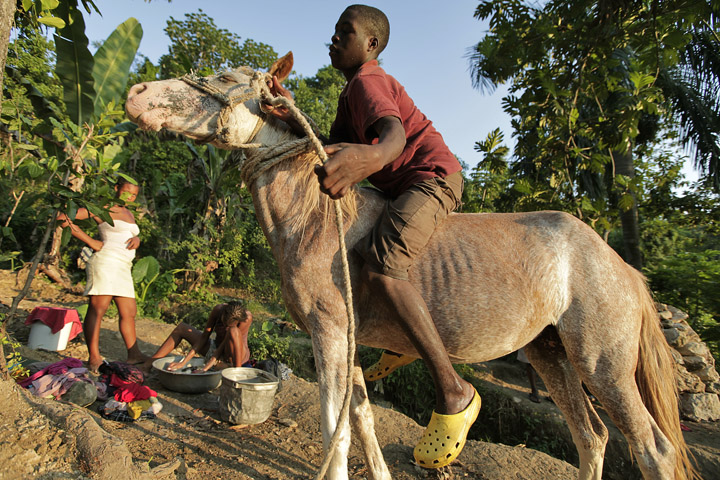

P E T E R P E R E I R A
p h o t o j o u r n a l i s t


ALL PHOTOS COPYRIGHT PETER PEREIRA
Haitiís mountain people
By Peter Pereira
An hourís flight from the opulence of Miami is all it takes to reach the poorest nation in the Western hemisphere. The Republic of Haiti lies on the western-most part of the Caribbean island of Hispaniola which it shares with its larger neighbor the Dominican Republic. Haiti has been plagued by a turbulent past filled with political violence ever since Christopher Columbus landed there in 1492 and claimed it for Spain. Today more than 8,000 peacekeepers from the United Nations try to maintain civil order, but even they are not enough to keep the deadly violence from spilling onto the streets.
As a photojournalist I have always wanted to explore the people living in the mountains high above the capital city of Port-au-Prince to capture the desperate living conditions there. The opportunity came when I was invited by Catherine Liberles, a registered nurse at Massachusetts General hospital, to stay at the Saint Rock clinic in the mountains above Carrefour, a suburb of the capital.
The clinic is run by the Saint Rock Haiti Foundation out of Hull, Mass., which organizes week-long stays at the clinic for local doctors, nurses and others who want to help the people in the mountains. With more than 80 percent of its population living in poverty, and two-thirds of its 10 million people are unemployed, Haitians live day by day. Healthcare is a luxury that no one can afford.
As my flight banked for its approach into Port-au-Prince, I got my first view of the rugged mountains that make up the majority of Haitiís terrain. I was stunned at how much of the country is mountainous. Tall, green and very rough, these mountains descend from the interior toward the shore like a giant octopus. The cacophony smacks you as you make your way out of the small airport onto the streets outside. Unable to understand the French Creole that people speak, I was unsure but ready for my journey to the mountains.
Unpaved roads filled with holes and deep chasms on its clay surface caused by the heavy rains, snake their way up the mountain. The higher you go, the greater the view, as the road is marked by sharp turns overlooking steep ravines that lead your eye to the sprawling city at the oceanís edge.
High on the mountain, somewhere under its thick green foliage exists a hidden community. Unlike the typical village with roads radiating from a central location, in the mountains of Haiti people are hidden from sight. No community center, no street names, just rough clay roads that wind up and down the rugged mountainsides. Smaller paths are cut into the foliage on the side of the main road, leading you into the spaces between the foliage where people have made their homes.
Daily, once I was done photographing in the clinic, I would hike up the mountain to find the places the people called home. With only my cameras on my shoulders and a small bottle of water in my back pocket, I was ready to capture what I saw.
What I saw was at times wonderful, at times saddening. It was wonderful to be constantly greeted by welcoming smiles that radiated from these humble people, but sad to see how little they have, and how bleak their future looks. One occasion I walked onto a clearing to find a family washing their clothes, children playing with a well-used soccer ball. In a tiny room in the family home a young man was making a small chair from wood, in hopes of selling it to a tourist in the city below. In another instance, exactly one week before Thanksgiving back home in New Bedford, I found myself looking on as a mother sitting on the hard-packed ground cooked the eveningís dinner for her husband and her three children with the help of a small fire and a large pot. This meal was a simple combination of corn paste and a soup made of water and beans. This is what they ate yesterday. Itís what they will eat tomorrow.
Itís hard to imagine seeing six men running down the mountain carrying a man, who was suffering severe abdominal pain, on a makeshift chair to the clinic far below for help. The men, and the chair, are the ambulance.
What you think is unacceptable for most of us is the norm in the mountains above Carrefour. I hope these photographs provide perspective on the lives of the poorest of Haitiís poor.
